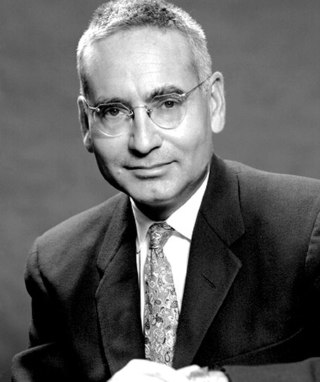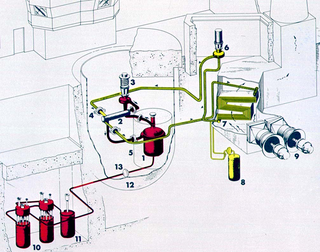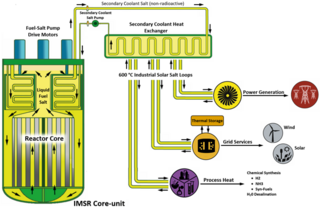
A breeder reactor is a nuclear reactor that generates more fissile material than it consumes. These reactors can be fueled with more-commonly available isotopes of uranium and thorium, such as uranium-238 and thorium-232, as opposed to the rare uranium-235 which is used in conventional reactors. These materials are called fertile materials since they can be bred into fuel by these breeder reactors.

A molten-salt reactor (MSR) is a class of nuclear fission reactor in which the primary nuclear reactor coolant and/or the fuel is a mixture of molten salt with a fissionable material.
Generation IVreactors are nuclear reactor design technologies that are envisioned as successors of generation III reactors. The Generation IV International Forum (GIF) – an international organization that coordinates the development of generation IV reactors – specifically selected six reactor technologies as candidates for generation IV reactors. The designs target improved safety, sustainability, efficiency, and cost. The World Nuclear Association in 2015 suggested that some might enter commercial operation before 2030.

The Aircraft Nuclear Propulsion (ANP) program and the preceding Nuclear Energy for the Propulsion of Aircraft (NEPA) project worked to develop a nuclear propulsion system for aircraft. The United States Army Air Forces initiated Project NEPA on May 28, 1946. NEPA operated until May 1951, when the project was transferred to the joint Atomic Energy Commission (AEC)/USAF ANP. The USAF pursued two different systems for nuclear-powered jet engines, the Direct Air Cycle concept, which was developed by General Electric, and Indirect Air Cycle, which was assigned to Pratt & Whitney. The program was intended to develop and test the Convair X-6, but was canceled in 1961 before that aircraft was built. The total cost of the program from 1946 to 1961 was about $1 billion.

The thorium fuel cycle is a nuclear fuel cycle that uses an isotope of thorium, 232
Th
, as the fertile material. In the reactor, 232
Th
is transmuted into the fissile artificial uranium isotope 233
U
which is the nuclear fuel. Unlike natural uranium, natural thorium contains only trace amounts of fissile material, which are insufficient to initiate a nuclear chain reaction. Additional fissile material or another neutron source is necessary to initiate the fuel cycle. In a thorium-fuelled reactor, 232
Th
absorbs neutrons to produce 233
U
. This parallels the process in uranium breeder reactors whereby fertile 238
U
absorbs neutrons to form fissile 239
Pu
. Depending on the design of the reactor and fuel cycle, the generated 233
U
either fissions in situ or is chemically separated from the used nuclear fuel and formed into new nuclear fuel.

Alvin Martin Weinberg was an American nuclear physicist who was the administrator of Oak Ridge National Laboratory (ORNL) during and after the Manhattan Project. He came to Oak Ridge, Tennessee, in 1945 and remained there until his death in 2006. He was the first to use the term "Faustian bargain" to describe nuclear energy.

The Molten-Salt Reactor Experiment (MSRE) was an experimental molten-salt reactor research reactor at the Oak Ridge National Laboratory (ORNL) in Oak Ridge, Tennessee. This technology was researched through the 1960s, the reactor was constructed by 1964, it went critical in 1965, and was operated until 1969. The costs of a cleanup project were estimated at $130 million.

The liquid fluoride thorium reactor is a type of molten salt reactor. LFTRs use the thorium fuel cycle with a fluoride-based molten (liquid) salt for fuel. In a typical design, the liquid is pumped between a critical core and an external heat exchanger where the heat is transferred to a nonradioactive secondary salt. The secondary salt then transfers its heat to a steam turbine or closed-cycle gas turbine.
The FUJI molten salt reactor is a proposed molten-salt-fueled thorium fuel cycle thermal breeder reactor, using technology similar to the Oak Ridge National Laboratory's Molten Salt Reactor Experiment – liquid fluoride thorium reactor. It was being developed by the Japanese company International Thorium Energy & Molten-Salt Technology (IThEMS), together with partners from the Czech Republic. As a breeder reactor, it converts thorium into the nuclear fuel uranium-233. To achieve reasonable neutron economy, the chosen single-salt design results in significantly larger feasible size than a two-salt reactor. Like all molten salt reactors, its core is chemically inert and under low pressure, helping to prevent explosions and toxic releases. The proposed design is rated at 200 MWe output. The IThEMS consortium planned to first build a much smaller MiniFUJI 10 MWe reactor of the same design once it had secured an additional $300 million in funding.
Stephen Tindale was a British environmentalist who was the executive director of Greenpeace in the United Kingdom from 2000 to 2005. He was director of The Alvin Weinberg Foundation, co-founder of the organisation Climate Answers, associate fellow at the Centre for European Reform and co-author of Repowering Communities with Prashant Vaze.

FLiBe is the name of a molten salt made from a mixture of lithium fluoride (LiF) and beryllium fluoride. It is both a nuclear reactor coolant and solvent for fertile or fissile material. It served both purposes in the Molten-Salt Reactor Experiment (MSRE) at the Oak Ridge National Laboratory.

Bryony Katherine Worthington, Baroness Worthington,, is a British environmental campaigner and life peer in the House of Lords. She has promoted change in attitudes to the environment, and action to tackle climate change. In 2008 she founded Sandbag, a non-profit campaign group designed to increase public awareness of emissions trading.

Thorium-based nuclear power generation is fueled primarily by the nuclear fission of the isotope uranium-233 produced from the fertile element thorium. A thorium fuel cycle can offer several potential advantages over a uranium fuel cycle—including the much greater abundance of thorium found on Earth, superior physical and nuclear fuel properties, and reduced nuclear waste production. One advantage of thorium fuel is its low weaponization potential. It is difficult to weaponize the uranium-233 that is bred in the reactor. Plutonium-239 is produced at much lower levels and can be consumed in thorium reactors.
Thorium Energy Alliance (TEA) is a non-governmental, non-profit 501(c)3, educational organization based in the United States, which seeks to promote energy security of the world through the use of thorium as a fuel source. The potential for the use of thorium was studied extensively during the 1950s and 60s, and now worldwide interest is being revived due to limitations and issues concerning safety, economics, use and issues in the availability of other energy sources. TEA advocates thorium based nuclear power in existing reactors and primarily in next generation reactors. TEA promotes many initiatives to educate scientists, engineers, government officials, policymakers and the general public.

The Integral Molten Salt Reactor (IMSR) is a nuclear power plant design targeted at developing a commercial product for the small modular reactor (SMR) market. It employs molten salt reactor technology which is being developed by the Canadian company Terrestrial Energy. It is based closely on the denatured molten salt reactor (DMSR), a reactor design from Oak Ridge National Laboratory. In addition, it incorporates some elements found in the SmAHTR, a later design from the same laboratory. The IMSR belongs to the DMSR class of molten salt reactors (MSR) and hence is a "burner" reactor that employs a liquid fuel rather than a conventional solid fuel. This liquid contains the nuclear fuel as well as serving as the primary coolant.

The Thorcon nuclear reactor is a design of a molten salt reactor with a graphite moderator, proposed by the US-based Thorcon company. These nuclear reactors are designed as part of a floating power plant, to be manufactured on an assembly line in a shipyard, and to be delivered via barge to any ocean or major waterway shoreline. The reactors are to be delivered as a sealed unit and never opened on site. All reactor maintenance and fuel processing is done at an off-site location. As of 2022, no reactor of this type has been built. A prototype of 500Mw (TMSR-500) output should be activated in Indonesia by 2029.
The Dual Fluid Reactor is a reactor concept of the Canadian company Dual Fluid Energy Inc. It combines techniques from molten salt reactors (MSR) and liquid metal cooled reactors. It is intended to reach the criteria for reactors of the Generation IV International Forum.
Transatomic Power was an American company that designed Generation IV nuclear reactors based on molten salt reactor (MSR) technology.

TMSR-LF1 is a 2 MWt molten salt reactor (MSR) pilot plant located in northwest China.
The Molten-Salt Demonstration Reactor (MSDR) was a semi-commercial-scale experimental molten salt reactor (MSR) design developed at Oak Ridge National Laboratory (ORNL).












